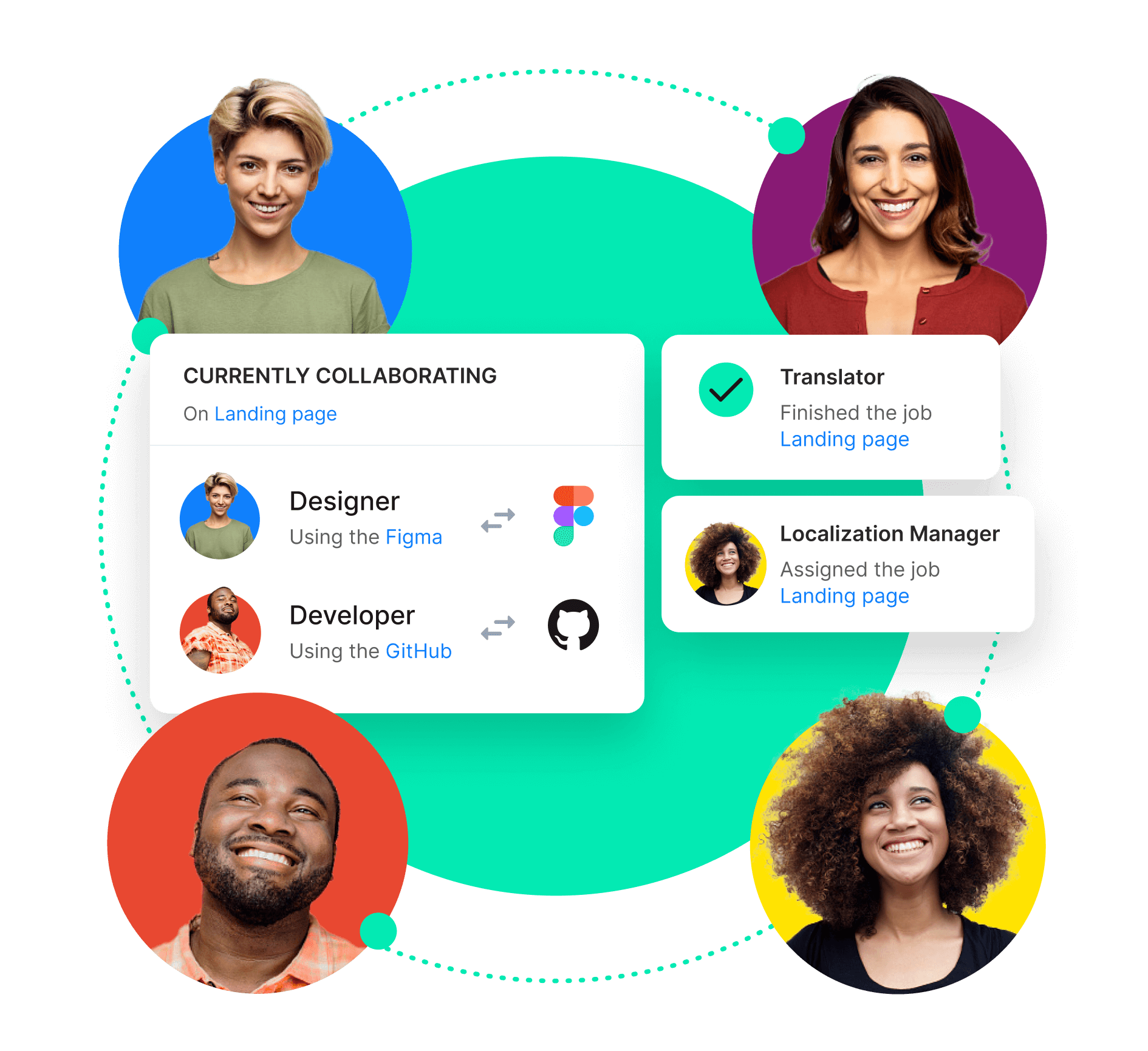Localization strategy
From Ground Zero to Global Hero: How to Make the Most of Product Localization

With the definition of a product becoming ever broader, a product today can be anything from a mobile app to a website. The way we sell products has also changed a lot: With a single click of a button, we can now reach potential customers online in any corner of the world.
To tap into this vast global market, you need to break down the language barrier and make your product accessible to people across cultures. Nevertheless, simply transferring your product documentation, web pages, or marketing materials from one language to another isn’t enough.
What you need to make your own is product localization—the process of adapting products to global markets. To help you get started, this guide explains why product localization is important for global business, how it differs from translation, and effective strategies to make it work for your product.
What is product localization?
Product localization is the process of adapting a product or service to the culture and language of customers in a specific target market. It includes everything from translating user interface (UI) elements and technical documentation to localizing marketing materials and web or mobile apps.
The goal of product localization is to make the product feel as if it were designed specifically for the target market rather than being an adapted version of the original. This enables you to break into different new markets simultaneously and more quickly.
Why is product localization important?
If you are an English speaker, it’s likely that most of the websites you visit and products you use are in English. So the need to localize might not be immediately apparent. However, the fact is that less than 20% of the world’s population is proficient in English.
If you truly want your product to reach a global user base, this means that a huge portion of the potential market is inaccessible to you—unless you invest in product localization. Localizing makes it easier to attract and convert the 80% of people who don’t speak English as a first language—research has found that 76% of customers prefer purchasing products with information in their own language.
Even if part of your audience may be fluent in English, they will often appreciate the effort you make to speak their language. It’s like a “friend or foe” test: If you’re willing to put in the extra work to connect with someone on their level, they are more likely to lower their defenses, trust you, and convert to the next stage.
For the same reason, just as important as localizing your product is making sure that you localize it well. Otherwise, the adapted version might feel artificial or even suspicious—and there are already too many examples of localization gone tragically awry.
What are the key benefits of product localization?
With a well-established product localization process, you get a more effective go-to-market strategy, speed up the time to market, and finally, increase your revenue.
A more effective go-to-market strategy
Expanding your business to new markets is a huge decision with many risks and challenges—but if you do it right, the potential rewards are great. A successful go-to-market strategy will ensure the delivery of the right message to the right audience at the right time. This, in turn, brings a business competitive advantage as a result of an enhanced overall customer experience. That’s where product localization comes in.
The process of localizing a product requires you to define your market positioning clearly by asking key questions about your target market: Who are they? What do they need? How can we reach them most effectively? The answers to these questions will shape not only the localized version of your product, but also your go-to-market strategy as a whole.
Faster time to market
Speed is often of the essence in business. Getting your product to market as quickly as possible helps generate revenue and feedback faster. And even when you’re established, being first to market with a new feature or product can make a big difference in your success. Localizing your product can help you achieve these goals if you approach it the right way.
A common mistake is to start the localization process too late, when the product is already complete. This can cause delays, because you end up needing to make changes to the code or UI if something doesn’t work in the new language.
However, if you take a “localize-from-the-start” approach, develop a solid localization strategy and incorporate localization into your development process from day one, you can launch your product in new markets much faster. This is because you’ll already have the infrastructure and processes in place to support localization, and each new market will require less work.
Higher revenue
Finally, product localization leads to higher revenues. Not only is “Can’t read, won’t buy” a mantra rooted in numbers—we’ve already seen how more than a third of consumers are most likely to buy from a brand in their own language—but companies that localize can also keep converted customers around for longer.
However, it goes deeper than that. User adoption is just as important as acquisition, and if customers won’t use your product because the user experience (UX) feels more like a translated version of something else, you’re not likely to see them again. In other words, localization is essential for customer retention as well as acquisition, both of which impact your bottom line.
How does product localization work?
Product localization has many moving parts. From preparing the code for translation and managing the actual localization process to testing and maintenance, there’s a lot to consider. To give you a better idea of what’s involved, let’s take a look at the main elements of product localization:
Internationalization: Making your product ready for localization
Before even thinking about localization, you need to internationalize your product. Internationalization (i18n) means building or designing your product in such a way that it can support different languages from that start. The process aims to prepare your product for localization.
Internationalization includes aspects like using the right text encoding (UTF-8 is a safe bet), adding support for right-to-left languages, and choosing a framework for exporting hard-coded string identifiers to allow for easy translation later on.
Actual product localization: Adapting software, websites, marketing collateral, and documentation
Once you’ve made sure your product is designed to support different languages and formats, it’s time to start localizing. The common elements you’ll want to localize include:
Software localization
The most important part of your product localization efforts is software localization. If you don’t localize the actual software product well, the other elements of your localization process won’t matter much.
This means that you need to adapt all UI elements, splash screens, in-app tooltips, and other in-product copy in a way that makes sense for your target market. It also includes things like changing units of measure, date formats, and currencies to match the local standards.
🗒 Tip » If your product is a mobile app, you must consider additional requirements to make it suitable for international markets. For example, keeping your copy up to date in all languages without forcing users to download the app for each update is key in app localization.
Website localization
Your website is often the first thing potential customers will see when they come across your product. If your visitors don’t get past the homepage, they’re not going to even see your product.
That’s why it’s important to take website localization seriously and make sure all your web pages are adapted accordingly. Again, this includes translating all text content into the target language, as well as adapting images, videos, and other visual elements.
🗒 Tip » If you have a blog or other dynamic content on your website, consider using an integration that automatically detects the user’s location and serves them the appropriate language version, along with the correct units of measure, currencies, etc.
Marketing localization
Marketing localization is about more than just translating your marketing materials into foreign languages. It’s about understanding the target market and adapting your message to resonate with them on a cultural level.
This includes everything from developing new taglines and slogans to creating entirely new ad campaigns specifically for the target market. In some cases, you might even need to develop a completely different brand identity that’s more in line with local preferences.
🗒 Tip » Transcreation is a specialized form of marketing localization that goes beyond simple translation and focuses on recreating the original message in a way that’s culturally relevant for the target market. Unlike localization, transcreation is usually done by copywriters, not translators.
Product documentation localization
Last but not least, it’s important to localize your product documentation and support content. This includes things like user manuals, how-to videos, FAQs, and so on.
It might seem like a lot of work for little gain, but keep in mind that being able to provide multilingual customer support is key for customer retention. Most customers will use this content to make themselves at home with your product. It also means that they’ll be less likely to contact customer support if they can figure out how to solve the problem on their own.
Poorly localized documentation is one of the nastiest concealed sources of customer churn and support expenses. So make sure to get it right, however daunting the task may seem.
🗒 Tip » Ensure that all “Learn more” and similar link buttons in your product UI are configured in such a way that they take users to a localized version of your documentation.
Localization testing and QA
Localization testing and QA, often called LQA in the industry, is an essential part of the localization process. It’s important to make sure that all localized versions of your product are functionally equivalent, and that all translated copy is accurate and error-free.
LQA involves the pre-launch process of verifying that a specific product build (e.g., a mobile app or website) works as expected in every market and meets the cultural, linguistic, and technical expectations of local users. It’s done one language at a time, and it’s planned rather than ad hoc.
Localization testing can be either functional, linguistic, or regional, and it’s important to use all three types to get a complete picture. Comprehensive localization testing should check that the product is working as expected in terms of:
- Strings, placeholders, and concatenations
- Software compatibility with the hardware used in the region
- Load times and responsiveness
- Cultural appropriateness of images, colors, and other visual elements
- Linguistic correctness and fluency of the translated copy
- Complete translations and correct context
- User journey and customer experience
- Region-specific features and compliance (e.g., GDPR for the EU)
- Currency, date, and time formats
🗒 Tip » Localization testing is a huge topic in its own right, and the required tests will vary based on your product and target markets, so be sure to check out our dedicated guide to localization testing and QA.
What are some good localized product examples?
Whether you’re just getting started with product localization or you’re looking for ways to improve your localization strategy, it can be helpful to look at some localization examples of global companies that have done it well. Here are a few notable examples:
Netflix
Netflix is a great example of a company that has successfully localized their product for global markets. When they first launched in 1997, Netflix was only available in the US.
As of 2022, they are operating in 190 countries and have plans to continue expanding their reach. To support this global expansion, Netflix invested heavily in localization, both in terms of their user interface and content. They even developed their own proprietary system, “Hydra,” to automate the localization process.
Netflix also has a dedicated team of localization experts who work closely with their content creators to ensure that all new titles are properly localized for each market. They also offer subtitles and dubbing in almost 30 languages.
This commitment to localization has paid off, with Netflix now having over 200 million subscribers worldwide. You can read more about Netflix’s localization strategy in their blog.
Airbnb
For a company whose very product is based on local experiences, it’s critical that they get localization right. So far, Airbnb has done an impressive job of adapting their platform to meet the needs of users in different markets. Airbnb offers their site and app in 62 languages, with plans to add more in the future.

“At Airbnb we define localization as deliberately creating products and services that are culturally appropriate, locally relevant, and globally consistent at scale,” says Salvo Giammarresi, Airbnb’s Head of Localization. We couldn’t have said it better ourselves.
PUBG
It’s one thing to localize a product for a broad audience. When it comes to video games, all hell can break loose if you don’t get the localization right. Just ask PUBG, who had to deal with a backlash when a new feature of their battle royale game reached the Arabic world.
The problem? The feature was about idol worshipping, which is forbidden in Islam. Needless to say, this caused quite a stir among PUBG’s Muslim players.
In response to the outcry, PUBG quickly issued an apology and removed the offending feature from the game. While this was certainly a PR nightmare, it’s also a good reminder of how important localization can be, even for products that are seemingly “universal.”
Navigating the often murky waters of video game localization is no easy feat. Despite mishaps like the one above, we think the team behind PUBG does a great job at localization, shipping the game in almost 20 languages. In either case, their experience is definitely worth checking out if your product is aimed at younger audiences.
How to integrate localization into product development?
Now that we’ve looked at some examples of companies who have done product localization well, let’s take a more practical look at how to integrate localization into your product development process.
Different approaches to product localization
There are two main approaches to localization: waterfall and agile, with continuous localization being the latter’s ultimate form.
The waterfall approach
The waterfall approach to localization is the more traditional of the two. In this model, all of the content for a product or service is translated before it is released in any market.
This can be a time-consuming and expensive process, and it’s also not popular among newer, agile development teams. However, it does have the advantage of ensuring that all of the content is properly localized before it goes live.
If you choose to go with a waterfall approach, it’s important to start planning for localization early on in the development process. This will give you enough time to get all of the content translated and ensure that it meets the localization requirements for each market.
The agile approach
The agile approach to localization is a more modern and flexible one. In this model, content is released in small batches as it is translated. This means that you can get your product or service to market faster, as you don’t have to wait for all of the content to be translated before you launch.
Agile localization also allows you to be more responsive to changes in the market. If something extraordinary happens, you can quickly adapt your localization strategy based on feedback from users.
If you choose to go with an agile approach, it’s important to have a versatile localization tool in place. This will allow you to manage the translation process and ensure that all of your content is localized consistently.
The continuous approach
Continuous localization is the ultimate form of agile localization. In this model, all content is translated as soon as it is created. This means that your product or service is always available in all markets, as there is no need to wait for content to be translated before it can be released.
Continuous localization requires a high level of coordination between the development and localization teams. It also requires a strong localization platform that can handle the large volume of content that needs to be translated.
If you choose to go with a continuous localization approach, it’s important to have a clear understanding of the workflow between the development and localization teams to ensure that everyone is on the same page and that content is translated efficiently.
How technology can help you manage the product localization process
No matter which approach to localization you choose, it’s important to have a good localization tool in place. This will make it easier to manage the translation process and ensure that all of your content is properly localized for each target market.
A recent report by Nimdzi Insights found that the current language technology landscape includes more than 700 solutions. Given this diversity, it can be difficult to know which tool is right for your business. To help you choose the right localization technology for your business, we’ve put together a list of features and benefits to look for:
- A translation memory is a database of previously translated content. It boosts translators’ efficiency by allowing them to reuse old translations, which in turn saves time and money, as you don’t have to pay for or work on translating the same content multiple times. Translation memories are also useful for maintaining consistency in your translations, as they ensure that similar content is translated in the same way each time.
- Term bases keep all of the terminology used in a project in one place so that it can be reused in future projects. This has a number of benefits, from reducing the need for human oversight to tracking changes in terminology over time, to ensuring that translations are consistent across different projects. Term bases also allow you to search for brand-specific or project-specific terminology, which can be useful when working on large or complex projects.
- Content integration is an essential feature of any localization tool claiming to adapt to agile processes. In order for localization to be truly agile, content must be able to flow freely between different systems. This means that your localization tool should be able to integrate with the rest of your tech stack, including your content management system (CMS), customer relationship management (CRM) system, ecommerce platform, etc. Content integration makes it possible for content to be translated and published without any manual intervention, which saves time and reduces the risk of errors.
- Project management features allow you to manage all aspects of the localization project in one place. This includes assigning tasks, tracking progress, managing deadlines, or sending notifications to project stakeholders. Project management features make it easier to keep a constant overview of the localization project and make sure that everything is on track. A centrally-managed project also makes it easier to track the progress of individual translators and identify potential bottlenecks in the translation process.
- Reporting and analytics features give you insights into the performance of your localization projects. This includes data on translation quality, project turnaround times, or translator productivity. Reporting and analytics can be used to optimize the localization process by ensuring that projects are completed on time and within budget and that stakeholders are kept up to date. You can’t improve what you don’t measure, so make sure to choose a localization tool that provides comprehensive data on your localization projects.
- Machine translation capabilities are a final factor to consider when choosing a localization tool. Machine translation (MT) can be used to speed up the translation process by automatically translating content. The amount of post-editing required will depend on your goals, the importance and visibility of the content, and the subject matter. For example, if you’re working on a time-sensitive project or translating large volumes of content, machine translation can be a valuable asset, so make sure to choose a tool that offers best-of-breed, AI-driven MT capabilities.
When it comes to product localization, there are a number of different technologies that you can use to get the job done. The right localization tool for your business will depend on a number of factors, including the size and complexity of your project, your budget, and your deadlines. Not all localization tools are created equal, so it’s important to find one that is a good fit for your particular workflow.
Most international businesses use some form of translation management system to manage their localization projects. A TMS is a cloud-based software platform that helps streamline the translation process, creating a workflow from the initial request to project completion and allowing users to plan, assign, and manage translation projects in an organized manner.
The best TMS solutions are flexible enough to allow users to create their own workflows and customize the software according to the needs of specific projects, departments, and teams. They are highly scalable and grow together with your business.
Navigating the world of product localization
Product localization is a complex process that requires careful planning and execution. When done right and typical localization pain points are taken care of, you might find that it is actually a lot of fun and the rewards of localized products are well worth the effort. A well-localized product will have a better chance of success in foreign markets, and it will also be more appealing to potential customers.
When planning a product localization project, it’s important to consider all of the factors that will impact the success of the project. This includes choosing the right localization strategy, selecting the right localization tool, and understanding the workflow between the development and localization teams.
By taking the time to complete every step of the localization process, from internationalization to launch and beyond, and integrating localization into your product development process, you’ll be one step closer to hitting your global growth goals.

Unlock global business with the Phrase Localization Platform
Expand into new markets with all the tools you need in one technology suite for high-quality, fast, and scalable localization.





